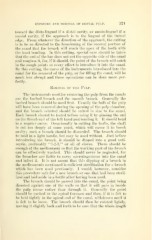Page 717 - My FlipBook
P. 717
EXPOSURE AND REMOVAL OF DENTAL PULP. 371
toward the disto-lingual if a distal cavity, or mesio-linf?ual if a
mesial cavity, if the approacli is to the lingual of the incisal
edge. From whatever the direction of the approach, the cutting
is to he so directed to the hroadening of the coronal portion of
the canal that the broach will reach the apex of thc^ tooth with
the least bending. In this cutting, special care should be taken
that the end of the bur does not cut the opposite side of the canal
and roughen it, for, if it should, the point of the broach will catch
in the rough points at every effort to introduce it into the canal.
By this cutting, the curve of the instruments introduced into the
canal for the removal of the pulp, or for filling tlie canal, will be
much less abrupt and these operations can be done more jjer-
fectly.
Eemoval op the Pulp.
The instruments used for removing the pulp from the canals
are the barbed broach and the smooth broach. Generally the
barbed broach should be used first. Usually the bulb of the pulp
will have been removed during the opening of the pulp cliam1)er,
and the broach selected should be suited in size to the canal.
Each broach should be tested before using it by placing the end
on the thumb nail of the left hand and Ijending it. It should bend
in a regular curve. Occasionally in cutting the barbs, the shaft
is cut too deeply at some point, which will cause it to break
easily; such a broach should be discarded. The broach should
be held in a light handle, but may be used without. Just before
introducing the broach, it should be dipped into a good anti-
septic, preferably "1-2-3," or oil of cloves. There should be
enough of the medicament so that the working part of the broach
can be effectively washed. This should never be neglected, for
the broaches are liable to carry microorganisms into the canal
and infect it. It is not meant that this dipping of a broach in
the medicaments mentioned is sufficient sterilization for a broach
which has been used previously. I would, however, consider
this procedure safe for a new broach or one that had been steril-
ized and laid aside in a bottle after having been used.
The broach should be passed into the canal, the point being
directed against one of the walls so that it will pass in beside
the pulp tissue rather than through it. Generally the point
should be pushed to the apical foramen and then, if it is felt to
be held tightly in the apical end of the canal, withdrawn until it
is felt to be loose. The broach should then be rotated lightly,
moving it slightly back and forth to be sure that the whole length


